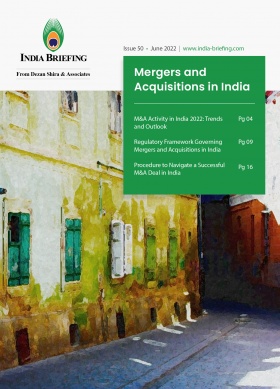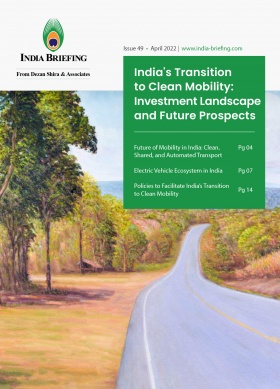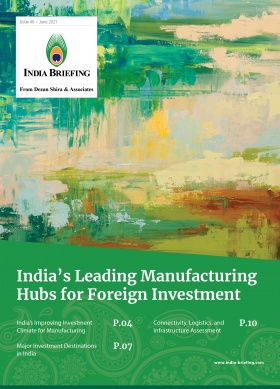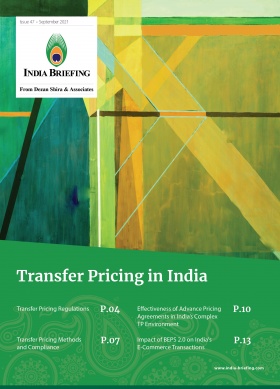Micro, Small, and Medium Enterprises in India: An Explainer
India has the largest MSME base in the world after China. The sector provides a wide range of services and is engaged in the manufacturing of over 6,000 products – ranging from traditional to hi-tech items. Given the government of India’s push for a self-reliant economy or Atmanirbhar Bharat, the Indian MSME sector is poised for rapid growth and is seeking greater integration with major global value chains.
India’s micro, small, and medium enterprises (MSMEs) enjoy significant government policy support, such as through sector-based production-linked incentives (PLI) programs, incentives targeting specific regions like the Northeastern states, or schemes for businesses linked to technical skilling and digital tools, applications, and technologies, among others. Relief measures are announced from time-to-time to combat force majeure events like the COVID-19 pandemic.
MSMEs in India: A quick overview
As per some estimates, there are about 63.05 million micro industries, 0.33 million small, and about 5,000 medium enterprises in the country. The state of Uttar Pradesh has the largest number of estimated MSMEs with a share of 14.20 percent of the total MSMEs in the country. West Bengal comes as close second with a share of 14 percent, followed by Tamil Nadu and Maharashtra at eight percent.
Responding to parliamentary questions in a written reply (July 15, 2022), the Ministry of State for Micro Small and Medium Enterprises stated that MSMEs contributed to 35.98 percent of India’s total manufacturing output in 2020-21, albeit down from 36.68 percent in 2019-20.
In FY 2020-21, MSME products accounted for 49.4 percent of India’s exports, which decreased to 45.0 percent in 2021-22 and further to 43.6 percent in 2022-23.
Per the Udyam Registration Portal, the total number of persons employed in MSMEs registered between July 1, 2020, and August 1, 2023 amounted to 1,236,15,681.
As per a 2022 Assocham-Crisil report titled ‘MSMEs back to the grind’, MSMEs provide employment to about 111 million persons in India and contribute to approximately 50 percent of overall exports from the country. MSMEs account for 27 percent of India’s GDP and serves as the backbone of the economy.
As of June 2023, there were 20.09 million MSMEs registered on the Udyam portal, including 19.4 million micro enterprises, 554,000 small enterprises, and about 52,000 medium-sized enterprises.
How do you qualify as an MSME in India?
From July 1, 2020, the government has implemented the new categorization MSMEs in India based on an upward revision in the definition and criteria.
The definition of who qualifies as an MSME in India is based on investment and turnover and applies to entities in manufacturing and services sectors:
- Micro: Enterprises with investment in plant and machinery or equipment not more than INR 10 million and annual turnover not more than INR 50 million are defined as micro units.
- Small: Enterprises with investment in plant and machinery or equipment not more than INR 100 million and annual turnover up to INR 500 million are defined as small units.
- Medium: Enterprises with investment in plant and machinery or equipment not more than INR 500 million and annual turnover up to INR 2.5 billion are classified as medium-sized units.
The Micro, Small and Medium Enterprises Development (MSMED) Act, 2006 governs the coverage and investment ceiling of MSMEs in India. The Act recognizes two categories of MSMEs – manufacturing and services, whose definition criteria have now been rationalized on an equal footing as per market and price conditions.
Prior to May 2020, the MSMED Act, 2006 had provided separate definition criteria for manufacturing and service MSME units, with very low financial limits. Changes to these criteria were announced in the first tranche of the Atmnirbhar Bharat economic package on May 13, 2020, to address the impact of the COVID-19 pandemic.
How to register as an MSME in India?
The MSME Ministry notified a new procedure of registration via the Udyam Registration Portal, which came in effect July 1, 2020.
Any person who intends to establish a micro, small or medium enterprise may file the Udyam Registration online on the Udyam Registration portal, based on self-declaration with no requirement to upload documents, papers, certificates or proof.
On registration, the enterprise (referred to as “Udyam” in the Udyam Registration portal) will be assigned a permanent identity number called the “Udyam Registration Number”.
An e-certificate, namely, the “Udyam Registration Certificate” will be issued on completion of the registration.
Quick points:
- Only the Adhaar number will be enough for Udyam registration. The PAN and GST-linked details on investment and turnover of enterprises will be taken automatically from Government data bases. The Udyam online system is fully integrated with the Income Tax and GSTIN systems.
- The entire registration process is free of cost.
- On completion of the registration process, the Registration Certification is generated and sent to the applicant. The Certificate can also be printed from the portal itself.
- Udyam registration portal: https://udyamregistration.gov.in/Government-India/Ministry-MSME-registration.htm
What are opportunity areas for MSMEs in India?
Telecommunications
- Domestic manufacturing of low-cost mobile phones, handsets, and devices
- Manufacturing of telecom networking equipment, including routers and switches
- Manufacture of base transceiver station equipment
- Mobile customer data analytics – services oriented toward analytical solutions
- Development of value-added services
Healthcare
- Manufacturing of personal protective equipment (PPE)
- Manufacturing of low-cost medical devices, and medical accessories, such as surgical gloves, scrubs, and syringes
- Telemedicine
- Diagnostic labs
Electronics
- Domestic manufacturing of low-cost consumer electronics, consumer durables
- White goods (AC and LED)
- Nano-electronics and microelectronics
- Electronic Systems Design and Manufacturing, including semiconductor design, electronic components design and hi-tech manufacturing under India’s ‘National Electronics Mission
- Strategic electronics, as the government is keen on encouraging the domestic manufacturing of products needed by the security forces
Pharmaceuticals
- In July 2022, India launched three schemes under the banner ‘Strengthening Pharmaceuticals Industry‘ (SPI) for strengthening MSMEs in the pharmaceutical sector to upgrade technology, set up common research centers and effluent treatment plants in pharma MSME clusters, and create a database for the domestic pharmaceutical and medical device industry.
- The states of Andhra Pradesh, Gujarat, Maharashtra, and Goa are major pharmaceutical manufacturing clusters in India.
- The pharma sector is also a PLI beneficiary.
Other areas that offer opportunities for MSMEs include tourism; sustainability; hyperautomation, which include artificial intelligence (AI); machine learning (ML); RPA; and advanced analytics; information technology (IT) and IT-enabled services; chemical; automotive; renewables; gems and jewelry; textile; food processing; drones-as-a-service; and agriculture.
Employment generated by MSMEs in India
|
S.No. |
State/Union Territory |
2020-21* |
2021-22 |
2022-23 |
2023-24# |
Total |
|
1 |
Andhra Pradesh |
709,811 |
1,231,311 |
2,745,495 |
727,568 |
5,414,185 |
|
2 |
Arunachal Pradesh |
14,694 |
20,152 |
35,406 |
8,677 |
78,929 |
|
3 |
Assam |
234,963 |
561,497 |
956,912 |
394,341 |
2,147,713 |
|
4 |
Bihar |
694,423 |
1,447,440 |
2,175,714 |
606,625 |
4,924,202 |
|
5 |
Chhattisgarh |
282,710 |
398,414 |
556,453 |
162,031 |
1,399,608 |
|
6 |
Goa |
64,757 |
59,265 |
82,455 |
21,968 |
228,445 |
|
7 |
Gujarat |
2,466,078 |
2,241,194 |
2,439,554 |
822,168 |
7,968,994 |
|
8 |
Haryana |
1,284,400 |
1,175,432 |
1,255,892 |
465,005 |
4,180,729 |
|
9 |
Himachal Pradesh |
140,826 |
175,196 |
199,516 |
118,312 |
633,850 |
|
10 |
Jharkhand |
379,680 |
683,346 |
922,057 |
246,818 |
2,231,901 |
|
11 |
Karnataka |
1,957,273 |
2,757,427 |
3,578,112 |
1,311,507 |
9,604,319 |
|
12 |
Kerala |
674,974 |
763,846 |
851,407 |
236,464 |
2,526,691 |
|
13 |
Madhya Pradesh |
826,879 |
1,400,971 |
1,823,041 |
524,148 |
4,575,039 |
|
14 |
Maharashtra |
4,458,451 |
4,566,130 |
4,890,908 |
1,442,862 |
15,358,351 |
|
15 |
Manipur |
91,176 |
118,058 |
147,183 |
17,365 |
373,782 |
|
16 |
Meghalaya |
7,340 |
18,757 |
31,128 |
11,606 |
68,831 |
|
17 |
Mizoram |
9,499 |
20,606 |
69,215 |
18,488 |
117,808 |
|
18 |
Nagaland |
7,916 |
26,062 |
46,227 |
18,681 |
98,886 |
|
19 |
Odisha |
576,236 |
958,600 |
1,295,934 |
406,823 |
3,237,593 |
|
20 |
Punjab |
913,645 |
934,704 |
1,161,308 |
481,552 |
3,491,209 |
|
21 |
Rajasthan |
1,547,664 |
2,457,478 |
2,816,087 |
831,202 |
7,652,431 |
|
22 |
Sikkim |
3,412 |
10,429 |
15,247 |
7,488 |
36,576 |
|
23 |
Tamil Nadu |
3,335,236 |
4,054,934 |
4,662,649 |
1,474,860 |
13,527,679 |
|
24 |
Telangana |
1,648,221 |
1,982,579 |
2,677,513 |
875,418 |
7,183,731 |
|
25 |
Tripura |
15,196 |
83,737 |
179,287 |
33,383 |
311,603 |
|
26 |
Uttar Pradesh |
2,090,951 |
2,832,512 |
4,171,713 |
2,209,675 |
11,304,851 |
|
27 |
Uttarakhand |
217,210 |
403,177 |
401,591 |
124,721 |
1,146,699 |
|
28 |
West Bengal |
1,107,009 |
2,049,849 |
2,932,684 |
752,510 |
6,842,052 |
|
29 |
Andaman and Nicobar Islands |
10,248 |
173,158 |
35,782 |
5,491 |
224,679 |
|
30 |
Chandigarh |
103,597 |
67,930 |
69,163 |
19,223 |
259,913 |
|
31 |
Delhi |
1,333,992 |
1,189,801 |
1,236,440 |
814,990 |
4,575,223 |
|
32 |
Jammu And Kashmir |
190,902 |
385,608 |
698,551 |
234,669 |
1,509,730 |
|
33 |
Ladakh |
4,978 |
11,484 |
13,779 |
3,751 |
33,992 |
|
34 |
Lakshadweep |
220 |
811 |
1,375 |
212 |
2,618 |
|
35 |
Puducherry |
39,392 |
55,711 |
57,259 |
21,212 |
173,574 |
|
36 |
Dadra and Nagar Haveli and Daman and Diu |
66,442 |
47,643 |
42,783 |
12,397 |
169,265 |
|
Total |
27,510,401 |
35,365,249 |
45,275,820 |
15,464,211 |
123,615,681 |
|
*From July 1, 2020; #up to August 1, 2023
Source: Minister of State for Micro Small and Medium Enterprises, Shri Bhanu Pratap Singh Verma in a written reply to the upper house of parliament, August 7, 2023.
MSME schemes and government support measures
India has initiated various schemes and measures to allow MSMEs easier access to funds, to modernize the sector, and make it more competitive in the global market.
These include schemes for credit guarantee, MSME cluster development, regeneration of traditional industries, growth of rural industries, entrepreneurship and skill development, procurement and marketing support, promotion in the North East Region (NRE) and Sikkim, infrastructure development and capacity building, and digital tools, applications, and technologies, among others.
Examples include the Prime Minister’s Employment Generation program (PMEGP), Scheme of Fund for Regeneration of Traditional Industries (SFURTI), ‘Strengthening Pharmaceuticals Industry’ (SPI), A Scheme for Promoting Innovation, Rural Industry & Entrepreneurship (ASPIRE), Credit Guarantee Scheme for Micro and Small Enterprises (CGTMSE), Micro and Small Enterprises Cluster Development Program (MSE-CDP), procurement and marketing support scheme (PMS), Promotion of MSMEs in North Eastern Region and Sikkim, etc.
In more recent measures are the INR5 trillion-Emergency Credit Line Guarantee Scheme (ECLGS), a INR 500 billion equity infusion into the MSME sector through the MSME Self-Reliant India Fund, and the inclusion of Retail and Wholesale trades as part of the MSME category. Furthermore, initiatives like the “Champions” online portal, non-tax incentives for achieving higher MSME status, and the Raising and Accelerating MSME Performance (RAMP) program have been introduced to boost the sector’s growth.
Additionally, the Udyam Assist Platform (UAP) was launched on January 11, 2023 to formalize Informal Micro Enterprises (IMEs), enabling them to access benefits under Priority Sector Lending (PSL).
Relief measures to mitigate impact of COVID-19
Some of the concessions for MSMEs under Atmanirbhar Bharat Abhiyan to mitigate the negative impact of COVID-19 are listed below:
- INR 3 trillion worth Emergency Credit Line Guarantee Scheme (ECLGS) for businesses, including MSMEs. (Subsequently increased to INR 5 trillion under the Budget 2022-23.)
- No global tenders in government procurements worth up to INR 2 billion.
- INR 200 billion subordinate debt for stressed MSMEs.
- INR 500 billion equity infusion through the Self Reliant India Fund.
Micro and Small Enterprise-Cluster Development Program (MSE-CDP) Scheme
The Ministry of Micro, Small and Medium Enterprises has adopted the cluster development approach as a key strategy for enhancing the productivity and competitiveness as well as capacity building of micro and small enterprises (MSEs) and their collectives in the country.
A cluster is a group of enterprises located within an identifiable and as far as practicable, contiguous area or a value chain that goes beyond a geographical area and producing same/similar products/complementary products/services, which can be linked together by common physical infrastructure facilities that help address their common challenges.
The essential characteristics of enterprises in a cluster are:
- Similarity or complementarity in the methods of production, quality control and testing, energy consumption, pollution control, etc.
- Similar level of technology and marketing strategies/practices.
- Similar channels for communication among the members of the cluster.
- Common market and skill needs.
- Common challenges and opportunities that the cluster faces.
Key benefits under MSE-CDP Scheme:
- Creation of Common Facility Centers including Plug & Play Facilities.
- Support for Infrastructure Development Projects, including Flatted Factory Complexes.
Scheme applicable for:
- Existing Entrepreneurs (in form of a special purpose vehicle / SPV – which should be a section 8 company under the Companies Act, 2013).
New guidelines for 15th Finance Commission Cycle 2021-22 to 2025-26
- Common Facility Centers (CFCs): The central government grant will be restricted to 70 percent of the cost of project from INR 50 million to INR 100 million and 60 percent of the cost of project from INR 100 million to INR 300 million. In case of Northeast & Hill States, Island territories, Aspirational Districts, government grant will be 80 percent of the cost of project from INR 50 million to INR 100 million and 70 percent of the cost of project from INR 100 million to INR 300 million. The project for CFC with project cost more than INR 300 million shall also be considered but the Government assistance would be calculated by taking into account the maximum eligible project cost of INR 300 million.
- Infrastructure Development: The central government grant will be restricted to 60 percent of the cost of project from INR 50 million to INR 150 million for setting up of new Industrial Estate / Flatted Factory Complex and the grant will be 50 percent of the cost of project from INR 50 million to INR 100 million for up-gradation of existing Industrial Estate / Flatted Factory Complex. In case of NE & Hill States, Island territories, Aspirational Districts, the grant will be 70 percent of the cost of project from INR 50 million to INR 150 million for setting up of new Industrial Estate / Flatted Factory Complex and 60 percent of the cost of project cost from INR 50 million to INR 100 million for up-gradation of existing Industrial Estate / Flatted Factory Complex. The project for ID with project cost more than INR 100 million/INR 150 million can also be considered but the government assistance would be calculated by taking into account the maximum eligible project cost of INR 100 million/INR 150 million.
Source: Ministry press release dated May 27, 2022.
How to apply
Apply on https://cluster.dcmsme.gov.in
Status of the Micro and Small Enterprise Cluster Development Program across India
|
Status of MSE-CDP Interventions (as on April 22, 2022) |
||||
|
State |
Common Facility Centers (CFCs) |
Infrastructure Development (ID) projects |
||
|
Completed |
Ongoing |
Completed |
Ongoing |
|
|
Tamil Nadu |
26 |
|
35 |
|
|
Kerala |
12 |
4 |
8 |
4 |
|
Haryana |
3 |
7 |
28 |
0 |
|
Karnataka |
11 |
13 |
4 |
1 |
|
Maharashtra |
14 |
14 |
5 |
0 |
|
Madhya Pradesh |
0 |
3 |
14 |
11 |
|
Uttar Pradesh |
4 |
7 |
8 |
7 |
|
West Bengal |
6 |
7 |
5 |
4 |
|
Andhra Pradesh |
2 |
6 |
6 |
8 |
|
Telangana |
0 |
1 |
3 |
16 |
|
Gujarat |
2 |
10 |
2 |
0 |
|
Punjab |
2 |
6 |
3 |
17 |
Consult with our India offices for any business support and fulfilment of compliance obligations or for information on availing incentive schemes and eligibility for regulatory relaxations.
Also Read
- How Will India’s New Schemes RAMP and CBFTE Benefit Small Businesses?
- Revised MSME Competitive (LEAN) Scheme Launched in India to Boost Industry
- India’s Unicorn Startups: Sector Distribution, Funding, Global Profile
The article was originally published September 2019. It was last updated November 1, 2023.
About Us
India Briefing is produced by Dezan Shira & Associates. The firm assists foreign investors throughout Asia from offices across the world, including in Delhi and Mumbai. Readers may write to india@dezshira.com for more support on doing business in in India.
We also maintain offices or have alliance partners assisting foreign investors in Indonesia, Singapore, Vietnam, Philippines, Malaysia, Thailand, Italy, Germany, and the United States, in addition to practices in Bangladesh and Russia.
- Previous Article Key Considerations Before Selling Foreign Products in India
- Next Article Visa Clearance Streamlined by Indian Authorities for Chinese Professionals Engaged in PLI Sectors












